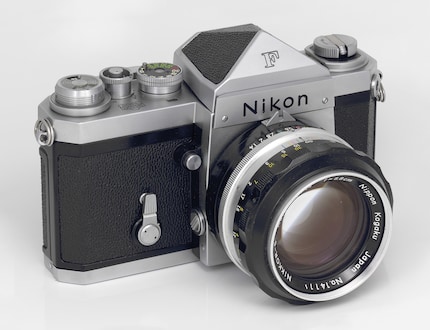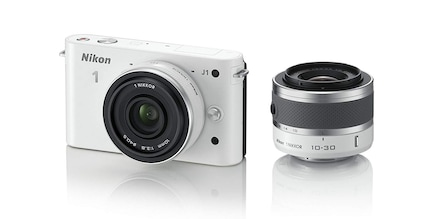
DJI Osmo Action 4 Standard Combo
120p, Bluetooth, Wi-Fi

Nikon will soon be marketing a mirrorless camera system. Although the company already had one. But the Nikon 1 system, announced to great fanfare in 2011, has quietly faded away. The story of a failure and what Nikon will (probably) do better this time.
For me, Nikon is a typically Japanese company. Conservative, solid and keen on quality. It plans and thinks long term. It improves its products in small steps. It continues to optimise even things that are almost perfect. Since 1959, the Japanese have been using the same lens mount, offering impressive backward compatibility.
Companies with this mindset are strong on evolution, but hate revolutions. If something shakes the whole industry and requires a quick reaction, they are often overwhelmed.
To tell the truth, I thought the idea of banking on a small sensor wasn't all that bad. Compactness was initially the main argument in favour of 'mirrorless'. A small sensor makes it possible to use not only very small cameras, but also small lenses. The problem of image noise would diminish over time. A long-term vision, then. What's more, the sensor was still much larger than for the compact cameras of the time.
The Nikon 1 was also a marketing disaster. At launch, Nikon tried to copy Apple's methods and played the total enthusiasm card. But the journalists who were there just didn't get the message. Perhaps this was due to the products themselves, but also to the fact that the enthusiasm on display didn't fit Nikon's decades-old corporate culture and just seemed played out.
With the new system, Nikon will admittedly once again have to contend with rival Sony, or Fujifilm in the case of a medium-format camera. Once again, things will not be easy, but the step taken seems reasonable, even necessary. We know that eternal rival Canon threw its own lens system completely overboard in 1987 and started from scratch. It was a big risk, but well worth it, and it may have paved the way for a modern system.
[[small:]]
My interest in IT and writing landed me in tech journalism early on (2000). I want to know how we can use technology without being used. Outside of the office, I’m a keen musician who makes up for lacking talent with excessive enthusiasm.
Interesting facts about products, behind-the-scenes looks at manufacturers and deep-dives on interesting people.
Show all
About ten years ago, Panasonic (2008) and Olympus (2009) marketed the first Micro Four Thirds systems. It was the start of a new era for digital cameras, that of mirrorless SLRs. Even though at the time the performance of electronic viewfinders was still inferior to the optical image of SLRs, Nikon could not ignore the new technology. The advantages were too obvious: more compact cameras, better video function, no blurred images due to the mirror spring and hyper-fast consecutive photos, as there was no mirror to keep moving.
.
Nikon had to react. In autumn 2011, the company launched the Nikon 1 mirrorless system with two models, four lenses and other accessories. All in compact dimensions and an attractive design in several colours. The name "1" refers to the size of the sensor: the diagonal is 1 inch. Much smaller than the competition.

But somewhere along the line, the concept wasn't thought through or developed to the end. It didn't emerge what the Nikon 1 should be or who it should be aimed at. It was a bit of everything and nothing. To replace the compact camera, it was too difficult to handle and too expensive. As a replacement for a DSLR, it wasn't powerful enough and offered few controls to begin with. The camera would have been perfect for action and wildlife photography thanks to the crop factor and high speed, but a powerful telephoto lens didn't come to market until 2014. While the adapter for existing lenses also enabled extreme telescopic effects, it only offered crippled autofocus that couldn't be used for action shots.

Added to this were developments that Nikon failed to anticipate, at least not in time. With the RX100, Sony launched a compact camera with a sensor of the same size, but with smaller dimensions and no inconvenient lens changes. At the same time, the cameras built into smartphones became so powerful that the market for compact cameras collapsed. The revenue that the company could have invested in the Nikon 1 system failed and the market, in which the Nikon 1 would have stood out from a quality point of view, fell apart.
Nikon itself, shortly afterwards, was already showing no enthusiasm. This was not without consequences. Anyone who invests in a new system wants to be sure that the manufacturer believes in it and continues to develop it. But Nikon hasn't released a new Nikon 1 camera in three years, and in the case of the high-quality V-series and lenses, more than four years have passed. There were always delivery problems, a sign that the models were no longer even being produced. In other words: Nikon 1 has been de facto dead since 2016, even though the manufacturer has never officially confirmed this.
The faster you die, the longer you stay dead. But now, after many barely containable rumours, it's official - Nikon is launching a new mirrorless system. This time with the right size sensor (probably full format, but medium format is not ruled out). The system will feature a new lens mount, so the huge range of lenses available to date can only be used with an adapter. It's quite possible, however, that this adapter will be very capable, not like the one on the Nikon 1.
We don't yet know exactly what Nikon will be presenting on 23 August. But one thing is certain, in its second attempt to make its mark in the world of 'mirrorless', Nikon is banking on quality. The approach is clear: no more trendy multicoloured cameras, which have never really suited Nikon's image anyway. It will probably be a range for professional photographers, like Sony's full-frame line-up. The company no longer wants to protect its own SLR cameras by marketing 'inferior' products. In fact, the opposite will be true: SLR cameras will be retained as a cheap alternative to more expensive, modern mirrorless cameras. In the teaser video, it is revealed that Nikon was preparing the new system for the next 100 years. We find the attachment to the long term.

DJI Osmo Action 4 Standard Combo
120p, Bluetooth, Wi-Fi